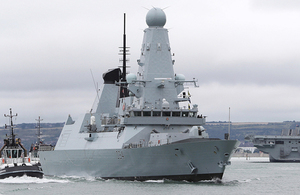Multi-million-pound contract to enhance Royal Navy Type 45 fleet resilience
The Ministry of Defence has announced a £160 million contract with BAE Systems to update the power and propulsion system fitted to the Royal Navy's Type 45 destroyers.

Royal Navy warship HMS Diamond sailing from Portsmouth Naval Base for a nine-month operational deployment. Crown copyright.
The Power Improvement Project (PIP) will enhance the resilience of the Type 45 class by installing additional power generation sources in each ship. Delivered as a major conversion project, the PIP will replace the two existing generators with three larger units capable of delivering the ships propulsion.
The contract has been awarded to BAE Systems, in collaboration with BMT Defence services and Cammell Laird. The physical conversion work will be conducted at Cammell Laird’s ship yard in Birkenhead, Merseyside, sustaining more than 100 highly skilled jobs.
The PIP contract covers the design and integration of the technical solution, supply of equipment and physical installation into all six Type 45 destroyers.
The contract forms part of Project Napier which was established in 2014 and builds on the work carried out in the first strand of the project, known as the Equipment Improvement Plan which addresses the reliability of existing equipment.
Director Ships Support at the MOD’s Defence Equipment and Support organisation, Neal Lawson said:
This contract demonstrates our ability to collaborate effectively with industry and I am extremely pleased with how the team at DE&S have worked rapidly to meet requirements.
The PIP will ensure the fleet of highly sophisticated Type 45s can continue to be deployed successfully on operations around the globe, protecting the UK’s interests worldwide.
The Power Improvement Project demonstrates how the MOD is delivering on the commitment as outlined in the last Strategic Defence and Security Review, to provide a robust solution to the power and propulsion issues observed in Type 45.
The first of class conversion is expected to complete in 2021, with follow on ships completed during the early 2020s. The programme is dependent on the availability of ships to undertake the conversion, balanced against the Royal Navy’s standing and future operational commitments.